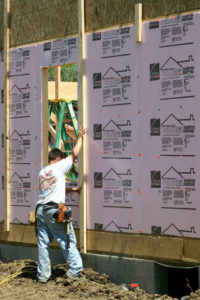
At the very core of budgeting is taking care of the basic needs of yourself and/or family: shelter, food, transportation and clothing. If your spending plan (budget) is not working, start fresh, assuring that your basic needs are being covered. It is not unusual to pay the ‘loudest’ bill, and forget to take care of the very things that will provide security and a sense of control.
The trick to preventing a crisis, is creating a haven of protection. If and when a financial crunch occurs, or when there is an unexpected interruption in income, security comes knowing the basic needs are covered for yourself and/or family.
The four walls seem simple enough, but don’t stop at the studs. Drywall needs to be applied in order to have walls where outside dangers can sneak in.
What are the four walls that can provide protection from outside danger? They are shelter, food, transportation and clothes – the basic requirements to be financially stable in today’s world.
Make sure the four walls are built correctly and in the sturdiest way possible.
- Shelter. Shelter includes wherever you live – an apartment, house, rented room, or dorm room. Not only does this wall include the costs of the roof over your head, but any expenses associated with it – heat, water and necessary* maintenance costs. Included in this category would be basic non-food necessities like toilet paper and cleaning supplies.
To assure that this wall is as sturdy as possible, adequate insurance needs to be in place which also means additional funds designated to protect the shelter.
*necessary maintenance is maintenance and/or repairs needed to assure your safety and security. Includes replacing a broken window, but not a dishwasher.
Action Step: Contact an independent insurance agent to have current insurance reviewed. If needed, purchase additional coverage or a policy to cover rented property.
- Food. Being well-nourished provides energy, a feeling of well-being, and aides in making wise decisions. Realistically, this line item in your budget, should only include the cost of eating at home. This does not include eating out, but providing for basic food needs. To be successful, you will need to PLAN, and purchase only what is needed. Focus on purchasing foods that give you bang for the buck. Example: oatmeal is an inexpensive breakfast food that offers the goodness of a whole grain, gives a sense of fullness. Other foods that offer good nutrition for the dollar are lean proteins, milk, cheese, and beans, fruit and vegetables. All are good for the budget and body!
If you have school–age children, include the costs of meals purchased at school and/or cost for sack lunches brought from home. Adults too can carry a sack lunch!
Action Step: Plan your meals, make a list of needed ingredients, and stick to it for one week. This will help determine the minimum dollar amount needed for this wall. As you make your meal plan, attempt to eat all meals at home, or pack your meal. Plan away-from home meals to be simple yet nutritious. Remember you are determining the minimum amount needed for this budget line. Still need help? Contact me for coaching on meal planning and/or grocery shopping on a budget.
- Transportation. The core definition for transportation is a way to be transported from one place to another. Whatever your mode of transportation: bicycle, public transportation, truck or car, all expenses related to this mode need to be included. Parking, gasoline, insurance and general maintenance. Depending on how far you drive every week and economics of your car, this category could be as little as $50 or as much as $300 per month. Current average for fuel for one care is $100-120.00 every month, plus additional funds for general maintenance. For regular oil changes, budget $40 every six weeks. Other costs to consider for transportation are insurance, tires, parking passes, other maintenance.
Action Step: Review your current insurance coverage. Could the deductible be raised to save on premiums? Find a mechanic that you trust and is willing to explain any maintenance needed and as the ability to make suggestions for delay, cheaper options, or danger.
- Clothing. Most of us have an abundance of clothes and can get by with just a few things. If you have children, they tend to grow, and need replacements. One way to make this line item less is to purchase needed clothes at re-sale shops, garage sales, or thrift stores. On the internet you discover ways to expand your wardrobe and ways to stretch your clothing dollar.
Action Step. Assess your closets. What needs to be replaced or updated within the next few months (don’t forget about shoes, upcoming special occasions, and growing children). Create a realistic budget for each person’s clothing needs. Put that amount of money in an envelope – only spend what is in the envelope.
Once the four walls and drywall are in place, you are ready to move on to the other things in your budget. If your income is unable to cover the four walls, then a closer look to evaluate income vs expenses may need to be made.
Building the four walls of your financial house first provides security, peace of mind, and foundation for a healthy budget. Need coaching? Call or text, 303-907-8736 or email kristin@familyhomeworks.com.
For the love of family,
Kristin